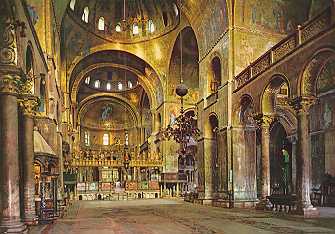(Musiche sacre 1656) - HMC 905219.20
During the second half of the sixteenth century there seems to have been a dramatic expansion not so much in the size of the cappella marciana as in the range of its activities. At first sight the contrast with the fifteenth century seems to be vivid, though an impression of a 'black hole' between the death of Ciconia (or rather that of de Quadris) and the arrival of Willaert as maestro di cappella in 1527 is probably more apparent than real, the product of the almost complete lack of late quattrocento Venetian sources on the one hand and the undervaluation of the importance of established traditions of cantus planus binatim on the other. Some sense of musical traditions at the Basilica during the intervening periodcan be gained from the descriptions of liturgical ceremonies contained in the diary of Arent Willemsz, a barber-surgeon from Delft who spent some weeks in Venice in 1525 en route for the Holy Land.(18) Willemz, who by profession must be counted a reasonably-educated and literate man(at one point he cites Isadore), gives as his reason for writing down such a detailed account of his journey the 'instruction and devotion of other pilgrims so that everyone can learn of the places where Christ carried out miracles'; as such, and in common with many other accounts written by pilgrims, the main weight of his diary falls on his description of the Holy Land itself and of the places associated with the life of Christ. From his writing it is evident that Willemsz was reasonably observant about human behaviour, but that at the same time he is inclined to be factual and to proceed cautiously, all of which makes him a witness of some reliability.
Like so many visitors to the city Willemsz was impressed by its sheer physical beauty, and he devotes considerable space to describing the standard sights including the Fondaco dei Tedeschi, the Arsenal and the Ghetto. Naturally enough, the most detailed of his descriptions of Venice is reserved for the Ducal Palace, the Basilica and the Piazza San Marco, and in particular for his experiences in the Corpus Christi procession and as a member of the congregation for mass and vespers inside the Basilica. It is the latter which is of particular interest since it usefully supplements and expands our understanding of the history and uses of the coro spezzato style in St. Mark' in the decades before Willaert's arrival. The most basic form of musical provision was provided by the canons of the Basilica; this involved an alternatim style in which some chanted and the remainder sang simple improvised polyphony. To this music, provided by what the documents describe as the small choir[capella parva], could be added extra polyphony sung by the musicians in the pulpitum magnum; presumably this would only be done on major feasts, and it is evidently what Willemsz heard when he attended Mass on a day of sufficient importance for the Pala d'oro to be open. By the time that the earliest surviving Ceremoniale for the Basilica had been compiled in 1564 the small choir had been discontinued and responsibility for polyphonic music was now solely in the hands of the cantores maioris capellae, the professional cappella of St. Mark's; they could perform from a number of places in the Basilica, but on major feasts sang from one of the two pulpits on the east side of the iconostasis, most usually from the pulpitum magnum. It was for this group, which were divided into two choirs with 'four singers in one choir and all the rest in the other, since the small choir no longer exists' as this Ceremoniale puts it, that cori spezzati settings were written from the time of Willaert onwards and conceivably before. The collection I salmi appertinenti alli vesperi of 1550, which contains music by Jachet of Mantua and Willaert, is the first printed monument to this Venetian version of what was evidently a north Italian practice(19), but the style itself persisted well into the seventeenth century by which time it had, of course, been joined by others including eight-voice concertato settings. It can still be identified in pieces by Rovetta, Cavalli, Grandi and Monteverdi, as in the latter's second 'Dixit Dominus' from the Messa... e Salmi(Venice, 1650) and in his settings of 'Memento[Domine, David] et omnis mansuetudinis' and 'Credidi propter quod locutus sum', both from the Selva Morale of 1640.
| Francesco
Cavalli: Lauda Jerusalem from Vespro della Beata Vergine
(Musiche sacre 1656) - HMC 905219.20 |
Here, as so often in the relationship between music and ceremonial in what was, after all, the most important church of the Republic, there seems to have been a broader set of principles at work. The musical style which the composers working at St. Mark's might choose for their works was not necessarily the result of free artistic design, but could be very closely constrained by liturgical function and by acute awareness of tradition.

St. Mark's Basilica. Interior with the Pala d'Oro open.
For the Venetians of the seicento, a period of decline and uncertainty, the service of Vespers on a major feast-day was a powerful evocation of the past glories of La Serenissima. Then, in a liturgical framework peculiar to the Basilica itself, before an from Byzantium, the singers of St. Mark's performed music in a way that recalled the roots of the Venetian tradition involving the simple alternation of chant and improvised polyphony.